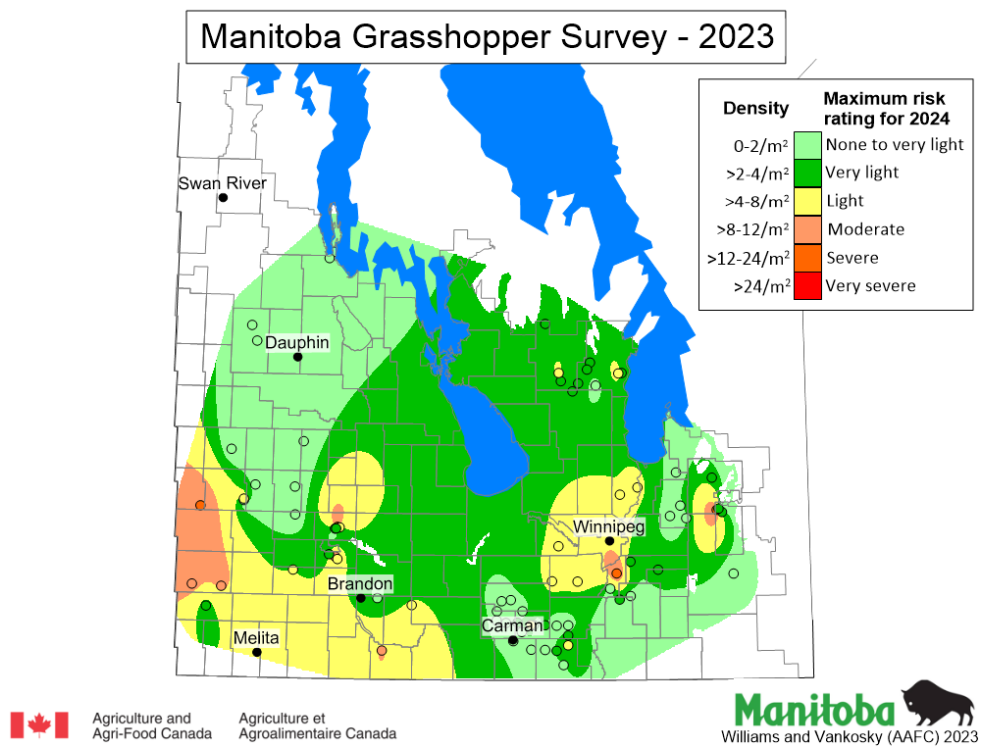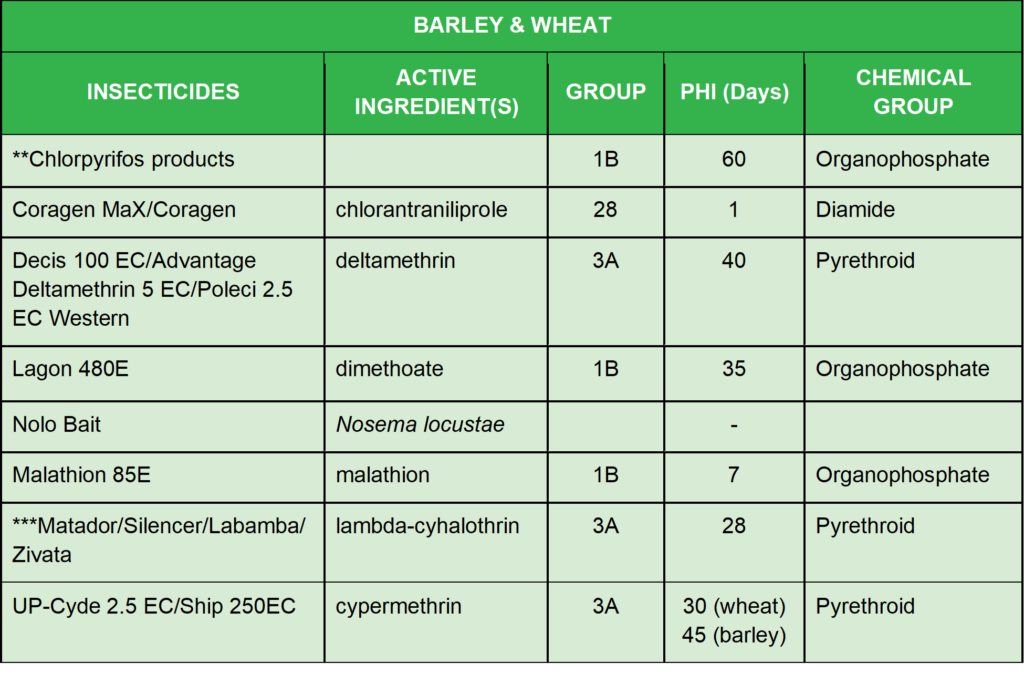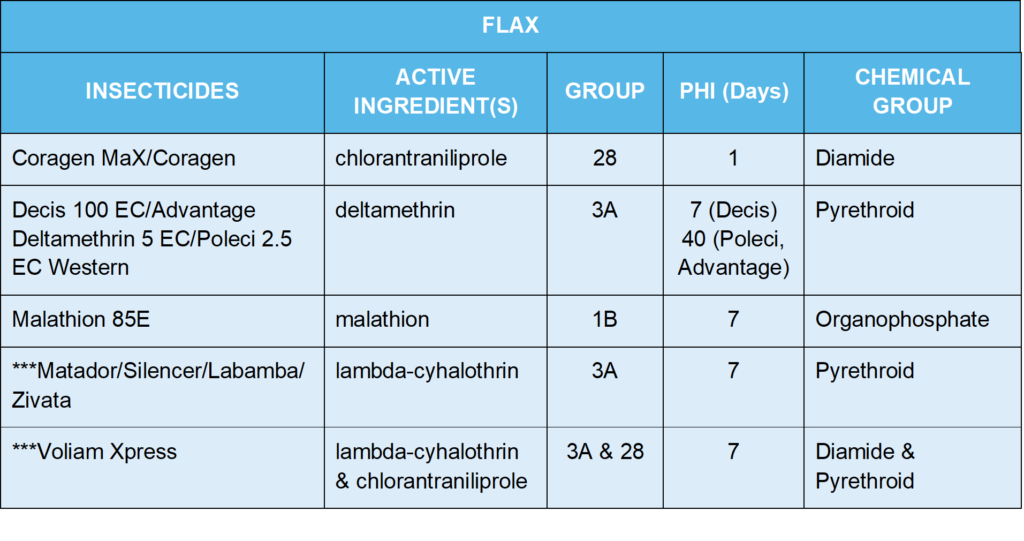Section Title
Grasshoppers: Forecast, Monitoring and Management
- Whole Farm
This resource was created in collaboration between Manitoba Crop Alliance, Saskatchewan Wheat Development Commission, Saskatchewan Barley Development Commission, Alberta Wheat Commission and Alberta Barley Commission.
2024 Grasshopper Forecast
Each year, Manitoba Agriculture prepares a forecast of the potential risk of grasshoppers to field crops. The 2024 forecast is based on counts of grasshopper populations in August 2023 done by entomologists, agronomists and extension specialists. It also incorporates weather data, recent trends in grasshopper populations and the presence of natural enemies. The forecast is intended to estimate the risk of pest grasshoppers, allowing farmers to adapt their management and monitoring practices.
The survey showed no to very light grasshopper populations across much of Manitoba, with a small number of counts in the eastern and southwestern regions indicating severe risk for 2024 (Figure 1). In most sampling locations, two-striped grasshopper was the most abundant species. At some locations, clear-winged or migratory grasshoppers were found to be the most abundant.
The complete Manitoba Grasshopper Forecast for 2024 is available here.

Figure 1: Average density of grasshoppers in Manitoba in August 2023.
Excess moisture in the spring may have farmers wondering about the survival of grasshopper populations. Across the prairie provinces, all pest species of grasshoppers overwinter in the egg stage, which is very tolerant to flooding. For this reason, spring moisture will have little impact on grasshopper survival.
Once grasshoppers hatch, persistent cool wet weather can reduce populations by slowing their development and increasing their susceptibility to predators and pathogens, while warm weather can result in quicker development. Farmers should scout along roadsides and field edges to catch young grasshoppers early in the season.
Identification and crop preferences

Figure 2: Two-striped grasshopper nymph.
Of the 85 species of grasshoppers across the prairie provinces, only four are potential pests of crops. The potential pest species are the migratory, two-striped, clear-winged and Packard grasshoppers.
- Migratory grasshoppers feed on both grasses and broadleaf crops. Preferred crops include both wheat and barley.
- Two-striped grasshoppers feed on both grasses and broad-leafed crops. Prefers heavier-textured soils. One of the earliest pest species to hatch.
- Clear-winged grasshoppers feed primarily on cereal crops, rarely on broadleaf crops.
- Packard grasshoppers will feed on both broadleaf plants and grasses. Prefers light textured soils.
Any grasshopper that is flying prior to June is not a pest species. Grasshoppers with red, yellow, orange or black wings when flying are not pests, and any grasshoppers that make noise are not pests, as pest species are silent. For details on identifying pest species of grasshoppers, see this factsheet from Manitoba Agriculture.
Scouting
Early season scouting is important to monitor and control pest species of grasshoppers in order to catch problems before damage is too great, and manage populations at the more susceptible nymph stage of their life cycle. Farmers should begin scouting in late May to early June. Cool conditions in the spring may slightly delay hatch to early to mid-June.
There are several ways to scout for grasshoppers or estimate damage:
- Metre square count: Count (or estimate) the number of grasshoppers that jump from a one-metre-square area as you walk towards it. Once you reach the area, disturb the plants with your feet to count any remaining grasshoppers Repeat at least 5 times, but do not continue to walk in a straight line to prevent overestimating populations. Note areas with higher populations such as field margins or wet areas during droughts.
- Sweep net sampling: Sweep net sampling should not be used to assess population levels, but can be useful for determining the species and stage of grasshopper populations to optimize management.
Management
Management through use of insecticides can be useful and effective. However, a variety of other practices can be implemented to manage pest grasshoppers or mitigate risk.
- Crop choice: Crops which may be planted early and grow rapidly before grasshoppers hatch will better withstand grasshopper feeding. Peas and oats are less preferred by grasshoppers, and may be used as guard strips around crops of concern.
- Seeding date: Plant crops as early as possible as older plants better withstand grasshopper feeding.
- Preservation of natural enemies: Many predators and parasitoids of grasshoppers exist. By minimizing the use of broad-spectrum insecticides when not needed, the populations of natural enemies will be maintained to keep grasshopper populations in check. For more information on the natural enemies of grasshoppers, see the Pests and Predators Field Guide from Field Heroes.
When populations of grasshoppers exceed 12 per square metre, control by insecticides may be required (Table 1).
Table 1: Grasshopper economic thresholds as recommended by Manitoba Agriculture and the Prairie Pest Monitoring Network.

When insecticides are required, young grasshoppers are much easier to control than older populations and are usually concentrated around field edges. In many cases, treating only the field margins with an insecticide is sufficient. To minimize risk to pollinators, avoid applying insecticides around the time of flowering for the crop and surrounding vegetation. If this is not possible, apply the insecticide late in the day or choose insecticides such as Coragen (chlorantraniliprole) or a bran bait such as Nolo Bait. For more information on how to reduce the impact of insecticide applications on beneficial pollinators, see this factsheet from Manitoba Agriculture.
The most suitable insecticide for the control of grasshoppers will depend on a variety of factors, including grasshopper growth stage, crop stage and temperature.
Table 2: Foliar and spreadable bran bait insecticides for grasshopper management*. Please note the footnotes for how to read the special notes within the tables.

*Information sourced from the Manitoba Agriculture Guide to Field Crop Protection 2024. Always refer to product label for application and efficacy details.
**Chlorpyrifos products will not be sold by retailers after December 2022. Farmers had until December 2023 to apply any remaining inventory before the product was officially unregistered and unusable for application. Source: Manitoba Agriculture.
***DO NOT cut treated fields for hay/forage. DO NOT graze treated fields. DO NOT feed treated crops to livestock. For grasses/non-grasses grown for seed production only, DO NOT feed seed screenings and aftermath to livestock.
Additional Resources
Manitoba Crop Alliance
Manitoba Agriculture
Agriculture and Agri-Food Canada
- Field Crop and Forage Pests and their Natural Enemies in Western Canada: Identification and Management
- Grasshopper Identification and Control Methods to Protect Crops and the Environment
Western Committee on Crop Pests: Guidelines for the Control of Insect Pests
Prairie Pest Monitoring Network














